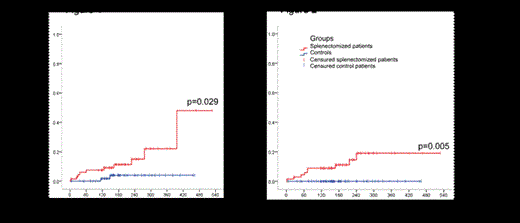Abstract
Introduction:
Splenectomy was historically regarded as the gold standard for treatment in chronic adult immune thrombocytopenic purpura (ITP). However, the recent emergence of new drugs has deeply modified ITP management and splenectomy is no longer viewed as an unavoidable step in adult chronic ITP in many countries. The estimation of the risk over benefit of this potential curative treatment remains challenging both for patients and physicians. A retrospective Italian study focused on long-term outcome of patients splenectomized for ITP gave reassuring data concerning safety. A recent study from a large cohort of American veterans showed an increased risk of death due to septicemia, pulmonary embolism, coronary artery disease and cancer more than 10 years after splenectomy. We reported here the results of the first single center case-control study evaluating the long-term incidence of splenectomy complications with a minimum follow-up of 10 years.
Methods:
We retrospectively selected in a clinical computer database all primary ITP patients splenectomized more than 10 years ago in our unit. We matched 1 by 1 to non-splenectomized ITP patients based on date and age at ITP diagnosis and sex criteria. Clinical data were then completed from medical charts. All patients were interviewed by phone and a standardized questionnaire was used. Medical records from general practitioner or from Medical care center have been systematically obtained if necessary, especially for deceased patients. Comparison between groups were made using Fisher’s test for qualitative variables, Kaplan-Meier method to estimate incidence and Rank test for comparison of cumulative incidence, with p<0.05 defining significance.
Results:
Seventy splenectomized ITP patients were included (19men/51women) with a median age at ITP diagnosis of 37 years (range: 3-92). Sixty one (87%) initially responded to splenectomy but only 34(48.5%) maintained a sustained response after a median follow-up of 189 months (range:120-528). Matched non-splenectomized ITP patients had a median age at diagnosis of 40 years (range: 3-93) and a median follow-up since ITP diagnosis of 197 months (range: 96-504).Cumulative incidence of thromboembolic events was higher in the splenectomized group (p=0.029) (Figure1). Four (6%) episodes of post-operative portal vein thrombosis were observed, 3 were complicated by portal cavernoma requiring long-term anticoagulation. They tended to present with more thromboembolic events on a long-term (n=7) than non-splenectomized ITP patients (n=3, p=0.113). Two splenectomized (2.8%) and 1 non-splenectomized (1.4%) patients were diagnosed with post-embolic pulmonary arterial hypertension. The incidence of cardiovascular events was significantly higher in splenectomized group (9(13%) versus 2(2.8%), p=0.005) (Figure 2) with 6 transient and/or ischemic strokes in splenectomized patients (none in non-splenectomized).Infectious events were similar in the two groups (splenectomized: 12 (17%) vs 10 (14%)) but infections were more frequent and severe in splenectomized patients. Indeed, 12 splenectomized patients presented 20 infectious events requiring hospitalization, 13 of them were pneumonia (Streptococcus Pneumoniae: n=4, Haemophilus Influenzae: n=1, undocumented: n=9). Five complicated septic-shocks leading to 3 deaths. In non-splenectomized group, 10 patients had 10 infectious events (Pneumonia n=4, Streptococcus Pneumoniae n=1), 7 were hospitalized, none had septic-hock. Incidence of cancer was similar in the 2 groups (splenectomized: 11 (16%), non-splenectomized: 10 (14%).Finally, the mortality rate was not different between two groups (splenectomized: n=14 (20%), non-splenectomized n=9, 13%). Ten (38%) of the 36 non-responders patients deceased, 7 from hemorrhage and/or septic shock. Other splenectomized and non-splenectomized patients died from malignant cancer/hemopathy (n=5), coronary artery disease (n=2),other (n=6).
Conclusion:
Based on this case control single center study, we observed that long-term splenectomized patients have not only an increase risk of life-threatening infections, but also an increased risk of thromboembolic, and cardiovascular events. A long-term follow-up is therefore recommended in this patient population regardless the status of ITP in order to better prevent and manage such complications.
No relevant conflicts of interest to declare.
Author notes
Asterisk with author names denotes non-ASH members.


This feature is available to Subscribers Only
Sign In or Create an Account Close Modal